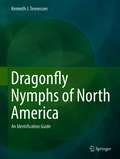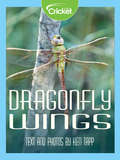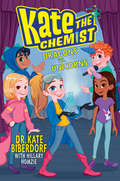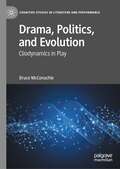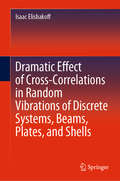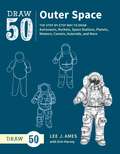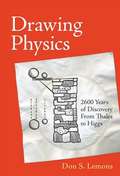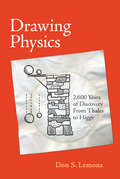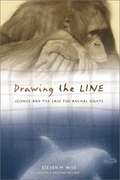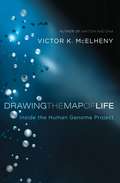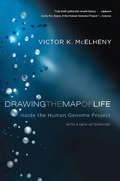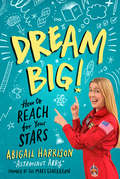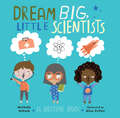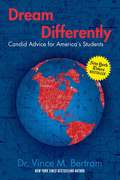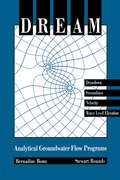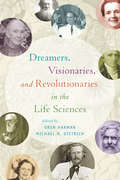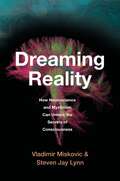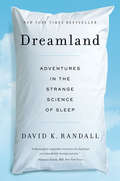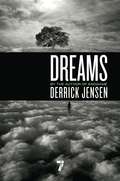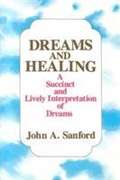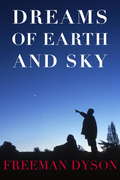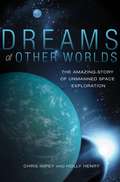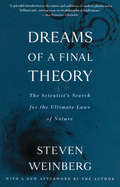- Table View
- List View
Dragonfly Nymphs of North America: An Identification Guide
by Kenneth J. TennessenThis monograph is the first of its kind devoted entirely to the dragonfly nymphs of North America north of Mexico, the focus being accurate identification of the 330 species of Anisoptera that occur in the region. Nymphal external morphology is described and illustrated in detail, and all terms needed to navigate the dichotomous keys are defined. Species are tabulated with references that provide the most detailed, accurate descriptions for each; species that are inadequately described are so indicated. The key separating the seven families in the region contains several new characters. The families are then covered separately: Aeshnidae (13 genera), Gomphidae (17 genera), Petaluridae (2 genera), Cordulegastridae (2 genera), Macromiidae (2 genera), Corduliidae (7 genera), and Libellulidae (29 genera). Each family is further characterized, followed by a generic key. A drawing of the habitus and diagnostic details for each genus are provided, along with additional diagnostic remarks and notes on habitat and life cycle; for each genus, a map shows its geographic distribution in North America. Full-grown nymphs of all known species of each genus are keyed and diagnosed; characters that apply to earlier instars are noted. Morphological variation in character states was analyzed in order to assess the reliability of previously utilized characters and to discover new characters. Most of the characters used to distinguish all levels of taxa are illustrated; a total of 702 figures, comprising 1,800 original drawings, along with selected photographs where necessary for clarity, accompany the keys. Measurements of total length, head width, and other variables for each species are provided in tables. Difficulties with past keys and descriptions, including errors, omissions and other shortcomings, are addressed. The importance of nymph characters in helping solve generic and specific distinctions and their role in phylogenetic studies is emphasized. Methods for collecting, rearing, and preserving dragonfly nymphs and exuviae are presented. The final chapter discusses research opportunities on North American Anisoptera nymphs, including taxonomic needs, studies on structure and function, life history and microhabitat, water quality indices and conservation efforts. The habitus drawings of all genera are arranged according to family in five plates (Appendix I); although the book is intended as a lab manual, these plates conveniently allow for comparison based on nymph shape making field identification to genus possible in many cases. Appendix II contains a brief history of dragonfly nymph studies in North America. A glossary and an index to scientific names are included.
Dragonfly Wings
by Ken TappThis summer, if you're lucky enough to have a dragonfly zip close to you or even land on you, pay close attention to its amazing wings!
Dragons vs. Unicorns (Kate the Chemist)
by Kate BiberdorfScience explosions! Theater! Mystery! Friendship! Fifth grader Kate the Chemist uses STEM knowledge to do incredible things! Kate the Chemist is a ten-year-old science problem solver. There's no problem Kate can't fix! When her best friend, Birdie, is cast as the lead unicorn in their school's musical Dragons vs. Unicorns, and Kate is chosen to be the assistant director, they agree this is going to be the best musical EVER! Kate is a natural assistant director; like all good scientists, she's smart and organized, but she also comes up with great ideas. But when everything starts going wrong with the musical and Kate realizes someone is sabotaging the show, will her special science sleuthing skills help save the day--and the show?Help young Kate the Chemist as she solves science problems in her community, starting with the school musical: Dragons vs. Unicorns!Praise for Kate the Chemist: Dragons vs. Unicorns:"Proves that science and fun go together like molecules in a polymer."--School Library Journal
Drainage Basin Dynamics: An Introduction to Morphology, Landscape and Modelling (Geography of the Physical Environment)
by Sandipan Ghosh Aznarul Islam Gouri Sankar Bhunia Pravat Kumar Shit Biswajit BeraThis volume provides a versatile introduction to the study of drainage basin evolution, morphology, drainage basin hydrology and sedimentology, human interference, natural and anthropogenic hazards and various management techniques. This book offers the responsible factors of sediment yield and their absolute and specific growth and rate of delivery through tributaries to the main streams. Rivers are important geomorphic agents which reflect an amazing variety of form and behaviour, showing the wide range of natural environment in which they are originated. The drainage system evolution and spatial network development within the dynamic nature are being discussed and how they are adjusted in the geomorphic time scale over the millions of years. This book shows how drainage systems function and react to change and why this thoughtful is required for flourishing integrated basin management. In tropical and sub-tropical countries population pressures as well as different developmental projects are being executed on the drainage basin without proper planning. Today scientists consider drainage basin as an administrative unit during implementation of regional projects. In this context this book will carry a bench mark for scholars and young scientists.
Drama, Politics, and Evolution: Cliodynamics in Play (Cognitive Studies in Literature and Performance)
by Bruce McConachieThis book outlines the evolution of our political nature over two million years and explores many of the rituals, plays, films, and other performances that gave voice and legitimacy to various political regimes in our species’ history. Our genetic and cultural evolution during the Pleistocene Epoch bestowed a wide range of predispositions on our species that continue to shape the politics we support and the performances we enjoy. The book’s case studies range from an initiation ritual in the Mbendjela tribe in the Congo to a 1947 drama by Bertolt Brecht and include a popular puppet play in Tokugawa Japan. A final section examines the gradual disintegration of social cohesion underlying the rise of polarized politics in the USA after 1965, as such films as The Godfather, Independence Day, The Dark Knight Rises, and Joker accelerated the nation’s slide toward authoritarian Trumpism.
Dramatic Effect of Cross-Correlations in Random Vibrations of Discrete Systems, Beams, Plates, and Shells
by Isaac ElishakoffThis volume explains the dramatic effect of cross-correlations in forming the structural response of aircraft in turbulent excitation, ships in rough seas, cars on irregular roads, and other dynamic regimes. It brings into sharp focus the dramatic effect of cross correlations often neglected due to the analytical difficulty of their evaluation. Veteran author Professor Isaac Elishakoff illustrates how neglect of cross correlations could result in underestimation of the response by tens or hundreds of percentages the effect of the random vibrations of structures’ main elements, including beams, plates, and shells.
Draw 50 Outer Space: The Step-by-Step Way to Draw Astronauts, Rockets, Space Stations, Planets, Meteors, Comets, Asteroids, and More
by Lee J. Ames Erin HarveyPart of the best-selling Draw 50 series this step-by-step guide to sketching and rendering astronauts, planets, asteroids, comets, spaceships, space stations, and other elements related to outer space exploration is for artists of all levels.In this new installment of Lee J. Ames's beloved Draw 50 series, readers will find easy-to-follow, step-by-step lessons for outer space drawing. In each lesson, six wordless steps provide everything needed to master drawing all kinds of planets, moons, comets, and meteors, as well as astronauts, rockets, spaceships, and other aspects--both natural and manmade--related to charting the cosmos.
Drawing Physics: 2,600 Years of Discovery From Thales to Higgs
by Don S. LemonsHumans have been trying to understand the physical universe since antiquity. Aristotle had one vision (the realm of the celestial spheres is perfect), and Einstein another (all motion is relativistic). More often than not, these different understandings begin with a simple drawing, a pre-mathematical picture of reality. Such drawings are a humble but effective tool of the physicist's craft, part of the tradition of thinking, teaching, and learning passed down through the centuries. This book uses drawings to help explain fifty-one key ideas of physics accessibly and engagingly. Don Lemons, a professor of physics and author of several physics books, pairs short, elegantly written essays with simple drawings that together convey important concepts from the history of physical science.Lemons proceeds chronologically, beginning with Thales' discovery of triangulation, the Pythagorean monocord, and Archimedes' explanation of balance. He continues through Leonardo's description of "earthshine" (the ghostly glow between the horns of a crescent moon), Kepler's laws of planetary motion, and Newton's cradle (suspended steel balls demonstrating by their collisions that for every action there is always an equal and opposite reaction). Reaching the twentieth and twenty-first centuries, Lemons explains the photoelectric effect, the hydrogen atom, general relativity, the global greenhouse effect, Higgs boson, and more. The essays place the science of the drawings in historical context -- describing, for example, Galileo's conflict with the Roman Catholic Church over his teaching that the sun is the center of the universe, the link between the discovery of electrical phenomena and the romanticism of William Wordsworth, and the shadow cast by the Great War over Einstein's discovery of relativity. Readers of Drawing Physics with little background in mathematics or physics will say, "Now I see, and now I understand."
Drawing Physics: 2,600 Years of Discovery from Thales to Higgs
by Don S. LemonsDrawings and short essays offer engaging and accessible explanations of key ideas in physics, from triangulation to relativity and beyond. Humans have been trying to understand the physical universe since antiquity. Aristotle had one vision (the realm of the celestial spheres is perfect), and Einstein another (all motion is relativistic). More often than not, these different understandings begin with a simple drawing, a pre-mathematical picture of reality. Such drawings are a humble but effective tool of the physicist's craft, part of the tradition of thinking, teaching, and learning passed down through the centuries. This book uses drawings to help explain fifty-one key ideas of physics accessibly and engagingly. Don Lemons, a professor of physics and author of several physics books, pairs short, elegantly written essays with simple drawings that together convey important concepts from the history of physical science. Lemons proceeds chronologically, beginning with Thales' discovery of triangulation, the Pythagorean monocord, and Archimedes' explanation of balance. He continues through Leonardo's description of “earthshine” (the ghostly glow between the horns of a crescent moon), Kepler's laws of planetary motion, and Newton's cradle (suspended steel balls demonstrating by their collisions that for every action there is always an equal and opposite reaction). Reaching the twentieth and twenty-first centuries, Lemons explains the photoelectric effect, the hydrogen atom, general relativity, the global greenhouse effect, Higgs boson, and more. The essays place the science of the drawings in historical context—describing, for example, Galileo's conflict with the Roman Catholic Church over his teaching that the sun is the center of the universe, the link between the discovery of electrical phenomena and the romanticism of William Wordsworth, and the shadow cast by the Great War over Einstein's discovery of relativity. Readers of Drawing Physics with little background in mathematics or physics will say, “Now I see, and now I understand.”
Drawing the Line: Science and the Case for Animal Rights
by Steven M. WiseAre we ready for parrots and dolphins to be treated as persons before the law? In this unprecedented exploration of animal cognition along the evolutionary spectrum--from infants and children to other intelligent primates, from dolphins, parrots, elephants, and dogs to colonies of honeybees--Steve Wise finds answers to the big question in animal rights today: Where do we draw the line? Readers will be enthralled as they follow Wise's firsthand account of the world's most famous animal experts at work: Cynthia Moss and the touchingly affectionate families of Amboseli; Irene Pepperberg and her amazing and witty African Grey parrot, Alex; and Penny Paterson with the formidable gorilla Koko. In many cases, Wise was able to sustain an extended conversation with these extraordinary creatures. No one with even a shred of curiosity about animal intelligence or justice will want to miss this book.
Drawing the Map of Life
by Victor K. McelhenyScience journalist McElheny charts the history of the human genome project from the discovery of DNA less than sixty years ago to the real possibility of recreating our own genetic coding. Along the way he puts faces to the scientists working on the project. He also covers the political and ethical debates. For some of the researchers, the search was intensified by personal experiences. One had a brother with Down Syndrome, another a child with schizophrenia. The wide-ranging possibilities of genetic manipulation are discussed, including retro-viruses to treat cancer and AIDS and increase food production. For the most part, McElheny concentrates on telling the story without becoming embroiled in the ethical and religious controversies surrounding the topic. Annotation ©2010 Book News, Inc. , Portland, OR (booknews. com)
Drawing the Map of Life: Inside the Human Genome Project (A Merloyd Lawrence Book)
by Victor K. McelhenyDrawing the Map of Life is the dramatic story of the Human Genome Project from its origins, through the race to order the 3 billion subunits of DNA, to the surprises emerging as scientists seek to exploit the molecule of heredity. It's the first account to deal in depth with the intellectual roots of the project, the motivations that drove it, and the hype that often masked genuine triumphs.Distinguished science journalist Victor McElheny offers vivid, insightful profiles of key people, such as David Botstein, Eric Lander, Francis Collins, James Watson, Michael Hunkapiller, and Craig Venter. McElheny also shows that the Human Genome Project is a striking example of how new techniques (such as restriction enzymes and sequencing methods) often arrive first, shaping the questions scientists then ask.Drawing on years of original interviews and reporting in the inner circles of biological science, Drawing the Map of Life is the definitive, up-to-date story of today's greatest scientific quest. No one who wishes to understand genome mapping and how it is transforming our lives can afford to miss this book.
Dream Big!: How to Reach for Your Stars
by Abigail HarrisonFrom Astronaut Abby, the dynamic founder of The Mars Generation, comes a book about dreaming big, reaching for the stars, and making a plan for success!From the age of four, Abigail Harrison knew she wanted to go to space. At age eleven, she sat down and wrote out a plan--not just for how to become an astronaut, but how to be the first astronaut to set foot on Mars. With a degree in biology, internships at NASA, and a national organization founded to help kids reach for the stars themselves, Astronaut Abby is well on her way to achieving her dreams--and she wants to help others do the same!In this book, readers will find helpful advice and practical tips that can help set them on the path toward finding, reaching for, and achieving their goals. With examples from Abby's own life, interactive activities to get readers going, and plenty of fun illustrations along the way, this is the perfect guide for anyone--of any age--with big dreams and plenty of determination. It's time to reach for the stars!Praise for Dream Big!:"With friendly encouragement . . . the content and approach are general enough to appeal both to STEM-oriented fans of the author as well as those whose interests lie in other areas . . . Fun and helpful." --Kirkus Reviews"Any young person who wants to achieve their dreams will find this comprehensive book helpful." --Booklist
Dream Big, Little Scientists: A Bedtime Book
by Michelle SchaubTwelve kids. A dozen bedtimes. Endless sweet ways to say goodnight with science!Spark curiosity and exploration with this innovative bedtime story for budding scientists that introduces eleven branches of science. From astronomy to physics to chemistry to geology, this STEM picture book will help kids get excited to explore. Includes further information about each branch of science.
Dream Differently: Candid Advice for America's Students
by Dr Vince M. BertramTo get the most out of your college education, you need to choose your classes wisely -- and increasingly, that means choosing STEM. Today's job seekers should have at least a basic understanding of trigonometry and other science, technology, engineering, and math (STEM) fields. The U.S. Bureau of Labor Statistics projects more than 1.3 million job openings in math and computer-related fields by 2022. The purpose of this book is not to push you into a STEM career; it is simply to provide you with information and perspective, as well as a few questions that, if answered honestly, will help you plot out an educational and career pathway that will help you achieve your dreams.
Dream-Analytical Ground Water Flow Programs
by Stewart Rounds Bernadine A. BonnValuable for consultants and regulators...Dream is a useful tool for basic field work, including the first-cut evaluation of remediation design. Ground water professionals will find Dream to be ideal for estimating actual flow conditions when information on aquifer properties is limited. Flow nets, streamline plots, and capture zone maps are easily produced by contouring Dream's output files. Maps of head, drawdown, and ground water velocity are equally simple to create. These provide an uncomplicated method for estimating both direction and magnitude of flow, and the areal extent of the well's influence. This must-have volume is valuable for hydrologists, regulators, ground water professionals, students, professors, and consultants. This work is a valuable teaching tool for principles of subsurface hydrology. It is easy-to-use and illustrates hydrologic concepts, pumping schemes, remediation schemes, etc. The importance of fundamental aquifer properties can be easily explored, at both the graduate and undergraduate levels.
Dreamers, Visionaries, and Revolutionaries in the Life Sciences
by Oren Harman Michael R. DietrichWhat are the conditions that foster true novelty and allow visionaries to set their eyes on unknown horizons? What have been the challenges that have spawned new innovations, and how have they shaped modern biology? In Dreamers, Visionaries, and Revolutionaries in the Life Sciences, editors Oren Harman and Michael R. Dietrich explore these questions through the lives of eighteen exemplary biologists who had grand and often radical ideas that went far beyond the run-of-the-mill science of their peers. From the Frenchman Jean-Baptiste Lamarck, who coined the word “biology” in the early nineteenth century, to the American James Lovelock, for whom the Earth is a living, breathing organism, these dreamers innovated in ways that forced their contemporaries to reexamine comfortable truths. With this collection readers will follow Jane Goodall into the hidden world of apes in African jungles and Francis Crick as he attacks the problem of consciousness. Join Mary Lasker on her campaign to conquer cancer and follow geneticist George Church as he dreams of bringing back woolly mammoths and Neanderthals. In these lives and the many others featured in these pages, we discover visions that were sometimes fantastical, quixotic, and even threatening and destabilizing, but always a challenge to the status quo.
Dreaming Reality: How Neuroscience and Mysticism Can Unlock the Secrets of Consciousness
by Steven Jay Lynn Vladimir MiskovicA cutting-edge neuroscientist and a leading clinical psychologist look to religious, mystical, and mind-altering experience to challenge scientific orthodoxies concerning consciousness.We are nothing but a pack of neurons, Francis Crick once said. Vladimir Miskovic and Steven Jay Lynn show that this way of thinking is both limited and an obstacle to understanding consciousness. In Dreaming Reality, Miskovic and Lynn connect the latest findings from neuroscience—which studies the brain from the outside in, as a purely physical object—to the insights of the world’s mystical traditions, which chart elaborate cartographies of the mind from inside out through experiences of meditation, prayer, and ecstasy. We can tackle the biggest questions surrounding the nature of consciousness when we place objective scientific research alongside the phenomenology of “altered” states.Dreaming Reality offers a rich synthesis of brains and minds, new and old, that challenges many cherished notions of how we experience our worlds and selves. Instead of privileging the experience of waking life, Miskovic and Lynn take this only as the starting point of a progressive disentanglement of consciousness. Delving into Buddhism, Vedanta, and Christian mysticism, they find that we have much to learn from dreams, hallucinations, visionary states, ego death, mind wandering, sensory deprivation, psychedelic experimentation, meditation, and minimal phenomenal experiences of consciousness.Each chapter brings us closer to understanding how we dream reality into existence and how we might transcend impoverished materialist models, whose unacknowledged effect is to drive us toward nihilism. Instead, we arrive at a model of consciousness that is more capacious and compassionate than biological sciences alone can imagine.
Dreamland: Adventures in the Strange Science of Sleep
by David K. RandallAn engrossing examination of the science behind the little-known world of sleep. <P><P> Like many of us, journalist David K. Randall never gave sleep much thought. That is, until he began sleepwalking. One midnight crash into a hallway wall sent him on an investigation into the strange science of sleep. <P><P> In Dreamland, Randall explores the research that is investigating those dark hours that make up nearly a third of our lives. Taking readers from military battlefields to children's bedrooms, Dreamland shows that sleep isn't as simple as it seems. Why did the results of one sleep study change the bookmakers' odds for certain Monday Night Football games? Do women sleep differently than men? And if you happen to kill someone while you are sleepwalking, does that count as murder? <P><P> This book is a tour of the often odd, sometimes disturbing, and always fascinating things that go on in the peculiar world of sleep. You'll never look at your pillow the same way again.
Dreams
by Derrick JensenJensen's furthest-reaching book yet, Dreams challenges the "destructive nihilism" of writers like Richard Dawkins and Sam Harris who believe that there is no reality outside what can be measured using the tools of science. He introduces the mythologies of ancient cultures and modern indigenous peoples as evidence of alternative ways of understanding reality, informed by thinkers such as American Indian writer Jack Forbes, theologian and American Indian rights activist Vine Deloria, Shaman Martin Prechtel, Dakota activist and scholar Waziyatawin, and Okanagan Indian writer Jeannette Armstrong. He draws on the wisdom of Dr. Paul Staments, author of Mycelium Running: How Mushrooms Can Help Save the World, sociologist Stanley Aronowitz, who discusses science's lack of accountability to the earth, and many more. As in his other books, Jensen draws heavily from his own life experience living alongside the frogs, redwoods, snails, birds and bears of the upper northwest, about which he writes with exquisite tenderness.Having taken on the daunting task of understanding one's dreams as a source of knowledge, Jensen achieves the near-impossible in this breathtakingly brave and ambitious new work.
Dreams and Healing
by John A. SanfordFollowing the enthusiastic reception of his earlier work, Dreams: God's Forgotten Language (Lippincott, 1968), John Sanford addresses himself again to the growing interest in dreams. He has produced a detailed and comprehensive examination of them by following the courses of the series of dreams of a young university student and a middle-aged woman. Dr. Sanford describes the unfolding of these dreams and relates them to the lives of the two individuals. He presents dreams as a wealth of creative possibilities, locked in the unconscious, on which we can draw by learning to understand and relate them to our lives. "Learning to work with our dreams will require from us time, commitment, and study. Our efforts can be well rewarded," observes Dr. Sanford. "To those who are in need, and to the strong of heart, the study of dreams and the human soul is a rich field of endeavor, and it is to these people that this book is written."
Dreams of Earth and Sky
by Freeman DysonIn this sequel to The Scientist as Rebel (2006), Freeman Dyson--whom The Times of London calls "one of the world's most original minds"--celebrates openness to unconventional ideas and "the spirit of joyful dreaming" in which he believes that science should be pursued. Throughout these essays, which range from the creation of the Royal Society in the seventeenth century to the scientific inquiries of the Romantic generation to recent books by Daniel Kahneman and Malcolm Gladwell, he seeks to "break down the barriers that separate science from other sources of human wisdom." Dyson discusses twentieth-century giants of physics such as Richard Feynman, J. Robert Oppenheimer, Paul Dirac, and Steven Weinberg, many of whom he knew personally, as well as Winston Churchill's pursuit of nuclear weapons for Britain and Wernher von Braun's pursuit of rockets for space travel. And he takes a provocative, often politically incorrect approach to some of today's most controversial scientific issues: global warming, the current calculations of which he thinks are probably wrong; the future of biotechnology, which he expects to dominate our lives in the next half-century as the tools to design new living creatures become available to everyone; and the flood of information in the digital age. Dyson offers fresh perspectives on the history, the philosophy, and the practice of scientific inquiry--and even on the blunders, the wild guesses and wrong theories that are also part of our struggle to understand the wonders of the natural world.
Dreams of Other Worlds
by Chris Impey Holly HenryDreams of Other Worlds describes the unmanned space missions that have opened new windows on distant worlds. Spanning four decades of dramatic advances in astronomy and planetary science, this book tells the story of eleven iconic exploratory missions and how they have fundamentally transformed our scientific and cultural perspectives on the universe and our place in it.The journey begins with the Viking and Mars Exploration Rover missions to Mars, which paint a startling picture of a planet at the cusp of habitability. It then moves into the realm of the gas giants with the Voyager probes and Cassini's ongoing exploration of the moons of Saturn. The Stardust probe's dramatic round-trip encounter with a comet is brought vividly to life, as are the SOHO and Hipparcos missions to study the Sun and Milky Way. This stunningly illustrated book also explores how our view of the universe has been brought into sharp focus by NASA's great observatories--Spitzer, Chandra, and Hubble--and how the WMAP mission has provided rare glimpses of the dawn of creation.Dreams of Other Worlds reveals how these unmanned exploratory missions have redefined what it means to be the temporary tenants of a small planet in a vast cosmos.
Dreams of Other Worlds: The Amazing Story of Unmanned Space Exploration
by Chris Impey Holly HenryDreams of Other Worlds describes the unmanned space missions that have opened new windows on distant worlds. Spanning four decades of dramatic advances in astronomy and planetary science, this book tells the story of eleven iconic exploratory missions and how they have fundamentally transformed our scientific and cultural perspectives on the universe and our place in it. The journey begins with the Viking and Mars Exploration Rover missions to Mars, which paint a startling picture of a planet at the cusp of habitability. It then moves into the realm of the gas giants with the Voyager probes and Cassini's ongoing exploration of the moons of Saturn. The Stardust probe's dramatic round-trip encounter with a comet is brought vividly to life, as are the SOHO and Hipparcos missions to study the Sun and Milky Way. This stunningly illustrated book also explores how our view of the universe has been brought into sharp focus by NASA's great observatories--Spitzer, Chandra, and Hubble--and how the WMAP mission has provided rare glimpses of the dawn of creation. Dreams of Other Worlds reveals how these unmanned exploratory missions have redefined what it means to be the temporary tenants of a small planet in a vast cosmos.
Dreams of a Final Theory
by Steven WeinbergThe Nobel Prize-winning physicist and bestselling author of The First Three Minutes describes the grand quest for a unifying theory of nature--one that can explain events as disparate as the cohesion inside the atom and the gravitational tug between the sun and Earth.From the Trade Paperback edition.
